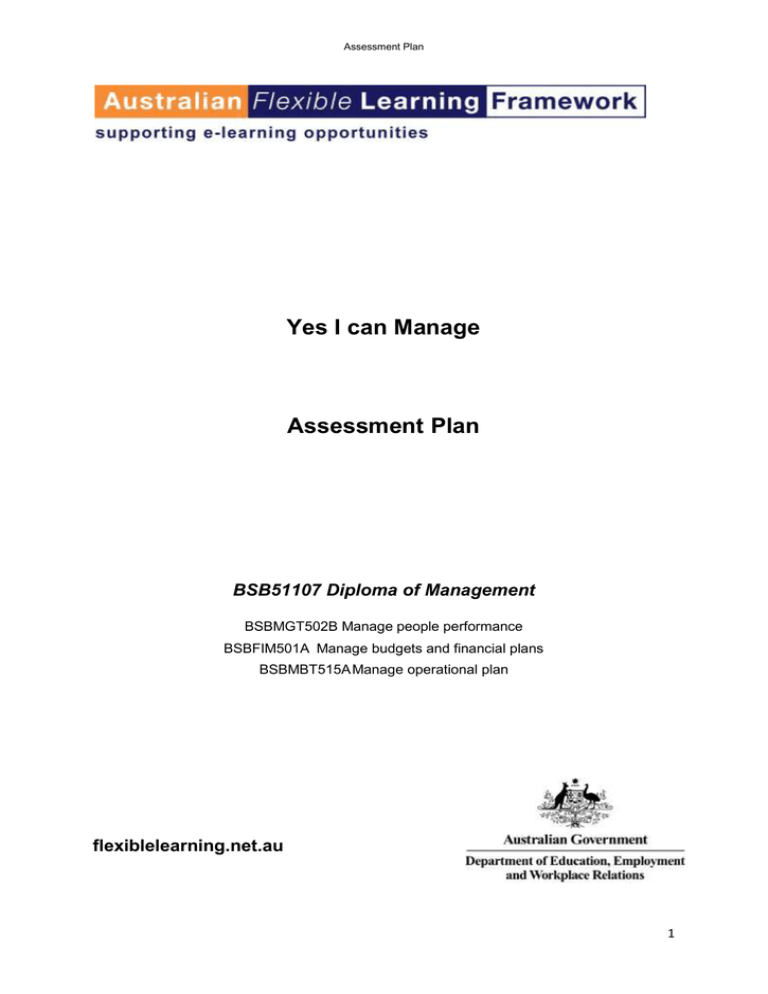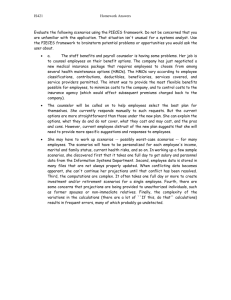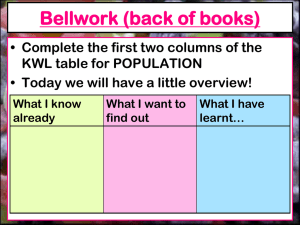Assessment Plan- Diploma of Management
advertisement

Assessment Plan Yes I can Manage Assessment Plan BSB51107 Diploma of Management BSBMGT502B Manage people performance BSBFIM501A Manage budgets and financial plans BSBMBT515A Manage operational plan flexiblelearning.net.au 1 Assessment Plan Acknowledgements This is a Tasmanian E-learning Innovations project output, developed by the Pharmaceutical Society of Australia, with seed funding from the national training system's e-learning strategy, the Australian Flexible Learning Framework (Framework). Project Team Content Writer Reviewer Instructional Designer Project Manager Yes I can Manage Dorothy Lucardie Tony Hughes Jenni Ireland Dorothy Lucardie Copyright statement This product has been produced on behalf of the national training system. It was funded under the 2010 Australian Flexible Learning Framework administered by the Commonwealth of Australia. © Commonwealth of Australia 2010 The views expressed in the copyright work do not necessarily represent the views of the Commonwealth of Australia. This work is copyright and licensed under the AEShareNet Share and Return Licence (AEShareNet–S Licence). The onus rests with you to ensure compliance with the AEShareNet-S Licence and the following is merely a summary of the scope of the Licence. Use of this work for purposes other than those indicated above, requires the prior written permission from the Commonwealth. Requests and notification of the distribution of Enhanced Versions should be addressed to Training Copyright, Department of Education, Employment and Workplace Relations, GPO Box 9880 Canberra City, ACT, 2601 or email copyright@training.com.au. Disclaimer The Commonwealth, through the Department of Education, Employment and Workplace Relations, does not accept any liability to any person for the information or advice (or the use of such information or advice) which is provided in this material or incorporated into it by reference. The information is provided on the basis that all persons accessing this material undertake responsibility for assessing the relevance and accuracy of its content. No liability is accepted for any information or services which may appear in any other format. No responsibility is taken for any information or services which may appear on any linked websites. 2 Assessment Plan Contents Units of Competency 4 Purpose of Assessment 4 Client Group 4 Assessors 5 Methods of assessment 5 Material/Equipment needed 5 Evidence Required 5 Recognition of Prior Learning 6 Mapping to the performance criteria 7 3 Assessment Plan Units of competency BSBMGT502B Manage people performance BSBFIM501A Manage budgets and financial plans BSBMBT515A Manage operational plan Purpose of Assessment Yes I can Manage assessment task has been developed to provide an integrated holistic assessment for three core competencies from the BSB51107 Diploma of Management. It has been developed as a summative assessment and covers the majority of the performance criteria of the three competencies. The outcomes of the assessment tasks produce evidence that meets the critical aspects of assessment for these competencies. The purpose of using this assessment tool is to provide a final assessment activity that demonstrates a candidate’s ability to use a number of skills and knowledge in typical managerial situations. The assessment tool presupposes that candidates have had the opportunity to display the building of their competence through formative assessment activities that may have occurred in the classroom, in the workplace or by distance or e learning opportunities. Client Group Candidates undertaking this assessment will be drawn from a wide range of industries as the Diploma of Management qualification applies across all areas. They may be currently in a management role or may be aspiring to achieve this role. This will mean that candidates will have varied experience in management and also come from different contexts where management skills and knowledge will be used. As candidates are expected to be varied, the role of the Assessor remains critical in the implementation of this tool. Special needs may be identified for some candidates using this tool such as vision impairment or English as a Second Language. In these cases the Assessor will be expected to adapt the assessment task to address access and equity issues. 4 Assessment Plan Assessors Assessors using this assessment tool must have the competencies being assessed or have been deemed to have these competencies through experience. They must have the Certificate IV in Training and Assessment or be under the supervision of a person with this qualification. Methods of assessment The Assessment task has been developed using the scenario of expanding an existing business and has three different contexts. One a retail business (Build It Fix It Hardware Store), a service business (Soothers Therapeutic Massage) and the candidates own business. Candidates are asked to select one context and work through the same tasks in the different contexts. The assessment tool provides information for each of the simulated businesses and the candidate is expected to source information from their own workplace if they have chosen that stream. Part 1 of the Assessment task provides an opportunity for candidates to demonstrate their skills and abilities to plan and prepare for the business expansion. Part 2 enables candidates to demonstrate their ability to monitor and make changes given information from budget variances and the staff scenarios. Material/Equipment needed The assessment task has been developed as an e learning object that is completed using a computer and word processing software. The e learning object can be made accessible from a web page, a portable device such as a CD or USB or from a network of computers. No additional software is required. Evidence Required Assessors may chose to use all or part of this assessment tool. In particular assessors may wish to choose a smaller number of staffing scenarios according to the needs of the individual candidate in terms of time and requirements to demonstrate competency. An assessment answer guide has been developed to provide assistance to assessors using this tool. Judgements of competency will remain with the assessor. 5 Assessment Plan Recognition of Prior Learning All candidates must have the opportunity to apply for recognition of prior learning for any or all of these competencies. Assessors may choose to delete some of the tasks according to candidates RPL. A mapping guide of the activities to Units/Elements and Performance Criteria is supplied. 6 Assessment Plan Mapping to the performance criteria Unit Performance Criteria Manage Operational Plan Critical Aspect Assessment task Development of an operational plan Must have access to appropriate documentation 1. Develop operational plan Research, analyse and document resource requirements and develop operational plan in consultation with relevant personnel, colleagues and specialist resource managers Develop operational plan Develop and/or implement consultation processes as an integral part of the operational planning process Not assessed Ensure details of the operational plan include the development of key performance indicators to measure organisational performance Develop operational plan √ Develop and implement contingency plans at appropriate stages of operational planning Develop contingency plans √ √ Consultation risk management Implementation not assessed 2. 3. Plan and manage resource acquisition Monitor and review operational performance Ensure the development and presentation of proposals for resource requirements is supported by a variety of information sources and seek specialist advice as required What resources Obtain approval for plan from relevant parties and ensure understanding among work teams involved. Submitted to assessor √ Develop and implement strategies to ensure that employees are recruited and/or inducted within the organisations human resource management policies and practices Recruiting and inducting staff √ Develop and implement strategies to ensure that physical resources and services are acquired in accordance with the organisation’s policies, practices and procedures Resources √ Develop, monitor and review performance systems and processes to assess progress in achieving profit and productivity plans and targets. Operational Planning √ √ Presented to Assessor Budget variance reports 7 Assessment Plan Staff scenarios Analyse and interpret budget and actual financial information to monitor and review profit and productivity performance. Budget variance reports √ Identify areas of under performance, recommend solutions, and take prompt action to rectify the situation Budget variance reports √ Staff scenarios Manage people performance Plan and implement systems to ensure that mentoring and coaching are provided to support individuals and teams effectively, economically and safely use resources. Staff scenarios √ Negotiate recommendations for variations to operational plans and gain approval for designated persons/groups. Submitted to Assessor √ Develop and implement systems to ensure that procedures and records associated with documenting performance are managed in accordance with organisational requirements Staff scenarios √ Critical Aspect Documented performance indicators and a critical description and analysis of performance management system from the workplace Techniques in providing feedback and coaching for improvement in performance Knowledge of relevant awards and certified agreements. 1. 2. Allocate work Assess performance Consult relevant groups and individuals on work to be allocated and resources available. Staff scenarios √ Develop work plans in accordance to operational plans Staff scenarios √ Allocate work in a way that is efficient, cost effective and outcome focussed. Staff scenarios √ Confirm performance standards, code of conduct and work outputs with relevant teams and individuals Staff scenarios √ Develop and agree performance indicators with relevant staff prior to commencement of work Staff scenarios √ Conduct risk analysis in accordance with the organisational risk management plan and legal requirements. Risk management plans √ Design performance management and review processes to ensure consistency with organisational objectives and policies Monitoring systems √ 8 Assessment Plan 3. 4. Provide feedback Manage follow up Manage budgets and financial plans Train participants in the performance management and review process Staff scenarios √ Conduct performance management in accordance with organisational protocols and time lines Staff scenarios √ Monitor and evaluate performance on a continuous basis Staff scenarios √ Provide informal feedback to staff on a regular basis Staff scenarios √ Advise relevant people where there is poor performance and take necessary actions Staff scenarios √ Provide on the job coaching when necessary to improve performance and to confirm excellence in performance Staff scenarios √ Document performance in accordance with the organisational management system Staff scenarios √ Conduct formal structured feedback sessions as necessary and in accordance with organisational policy Staff scenarios √ Write and agree performance improvement and development plans in accordance with organisational policies Staff scenarios √ Seek assistance from human resource specialists where appropriate Not assessed Reinforce excellence in performance through recognition and continuous feedback Staff scenarios √ Monitor and coach individuals with poor performance Staff scenarios √ Provide support services where necessary Not assessed Counsel individuals who continue to perform below expectations and implement disciplinary process if necessary. Staff scenarios √ Terminate staff in accordance with legal and organisational requirements where serious misconduct occurs or ongoing poor performance continues. Staff scenarios √ Critical Aspect Financial skills required to work with and interpret budgets, ageing summaries, cash flow, petty cash, GST and profit and loss statements. Knowledge of the record keeping requirements for the ATO and for auditing 9 Assessment Plan purposes. 1. 2. 3. 4. Plan financial management approaches Implement financial management approaches Monitor and control finances Review and evaluate financial management processes Access budget and financial plans for the work team Budgets in description √ Clarify budget/financial plans with relevant personnel within the organisation to ensure that documented outcomes are achievable, accurate and comprehensible Clarified with assessor √ Negotiate any changes required to be made to budget/financial plans with relevant personnel within the organisation Not assessed Prepare contingency plans in the event that initial plans need to be varied Contingency plans Disseminate relevant details of the agreed budget/financial plans to team members Not assessed Provide support to ensure that team members can competently perform required roles associated with the management of finances Staff scenarios √ Determine and access resources and systems to manage financial management processes within the work team Develop Operational Plan √ Implement processes to monitor actual expenditure and to control costs across the work team Monitoring processes √ Monitor expenditure and costs on an agreed cyclical basis to identify cost variations and expenditure overruns Budget variances √ Implement, monitor and modify contingency plans as required to maintain financial objectives Budget variances √ Report on budget and expenditure in accordance with organisational protocols Budget variances √ Collect and collate for analysis, data and information on the effectiveness of financial management processes within the work team Budget variances √ Analyse data and information on the effectiveness of financial management processes within the work team and identify, document and recommend any improvements to existing processes Budget variances √ Implement and monitor agreed improvements in line with financial objectives of the work team and the organisation. Budget variances √ √ 10




